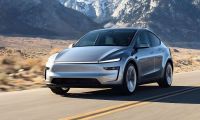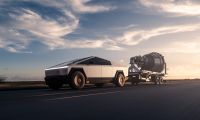The official results are in, and the all-new 2017 Prius Prime plug-in hybrid electric vehicle has topped every battery-electric automobile in America. With an EPA-estimated MPGe of 133, the Prius is ahead by a country mile.
Take the least expensive Tesla Model S as a comparison. The $70K battery-electric luxury car many see as the best EV on the market is about 33% less efficient than the Prius Prime with an 89 MPGe rating. What a glutton! The all-electric Nissan Leaf is much better, but not even close to the Prius Prime in energy efficiency. The more efficient of the two Leafs has a 114 MPGe rating. Finally, how about the newest affordable battery-electric vehicle, the Chevy Bolt? With a 119 MPGe rating it is very efficient, but it is still about 11% less efficient than the Prius Prime.
So, is it just that plug-in hybrids make the best use of energy, putting battery-electrics at a disadvantage? No, it is not. Take the Ford C-Max Energi plug-in hybrid. Its 88 MPGe rating is not even in the same league as the new Prius Prime. The new Hyundai Sonata Plug-in Hybrid’s 99 MPGe rating is also not even a fair comparison. Ford’s Fusion Energi Plug-in Hybrid is a top-seller, but its 98 MPGe rating is also significantly lower than the Prius Prime’s rating.
What is the number two-rated vehicle for MPGe? The BMW i3 BEV with a rating of 124 MPGe is the closest rival to the Prius Prime. It has a total range of 81 miles and has a price tag roughly double that of the Prius Prime.
There are also two other considerations that make the new Prius Prime a standout. One is the price. It is one of the lowest cost electric vehicles on the market. Second is range. With about 25 miles of EV range and a total range of 640 miles between fill-ups, the Prius Prime is hard to top. Wondering what the Prius Prime’s fuel efficiency when the battery is depleted? 54 MPG combined, the best among all competitors.













Comments
I have a Mitsubishi PHEV and
Permalink
I have a Mitsubishi PHEV and have got a best result of 233 MPG so far. I only fill up with petrol 4 tims a year and use th car every day.
What about the Kia Niro?
Permalink
What about the Kia Niro?
According to Kia, when the
Permalink
In reply to What about the Kia Niro? by George (not verified)
According to Kia, when the the Niro compact wagon comes this fall it will be a hybrid expected by Kia to earn a 50 MPG rating.
Deceptive.. 133 MPGe is very
Permalink
Deceptive.. 133 MPGe is very good but for a very small number of miles. On a typical commute, the Prius Prime will have to burn gas, so its efficiency will drop. The Tesla, BMW, or Chevy (Bolt or Volt) have enough range to go all electric for the typical commute, making them all more efficient than the Toyota.
But the car is so ugly
Permalink
But the car is so ugly
Your opinion is just as valid
Permalink
In reply to But the car is so ugly by Joyce Javier (not verified)
Your opinion is just as valid as anyone's, Joyce. But please tell us which 133 MPGe-rating vehicle starting under $23K after incentives you feel is better looking and why.
Only 25 miles EV range? Why
Permalink
Only 25 miles EV range? Why bother?
Excellent question.
Permalink
In reply to Only 25 miles EV range? Why by Doofus (not verified)
Excellent question. According to EV advocates, the average daily commute is 40 miles. If charging at work were offered, this vehicle would be gas free to and from work for most. There are those who find that important. The Prime also qualifies for a California (and other states') HOV lane, single occupancy sticker. Important to many who commute in these cities.
I have a Ford Fusion Energi
Permalink
In reply to Only 25 miles EV range? Why by Doofus (not verified)
I have a Ford Fusion Energi PHEV with only 21 miles before switching over to gas. Although it may sound little, over 80% of my driving is in electric mode. This means I only fill up once every two months with gas which is used predominantly for long distance trips. In fact, I am a strong believer in PHEV (plug in hybrids like the Prius Prime) is a better solution than all out EV. For the 20% driving that I need gas because it's more than 21 miles, I rather use gas than electricity anyways. The reason being is that it's much easier to fill-up with gas at a gas station than to find an electric fast charger. Those electric fast charger still needs 1~2 hours to fill-up compared to just a few minutes at the gas pump.
Hi Douglas. I would love to
Permalink
In reply to I have a Ford Fusion Energi by Douglas Peng (not verified)
Hi Douglas. I would love to expand on this excellent comment and create a "Myth-busted" type story around it. If you are interested, please reach out to me via the contact us tab here at TN. I will e-mail you back and send over some questions you can write back on. That and an image is all it would take to make your note into a great story. Many EV fans are skeptical that PHEVs are EVs, but you know the truth! I hope you will reach out. Thanks
Wrong, that is why Tesla is
Permalink
In reply to I have a Ford Fusion Energi by Douglas Peng (not verified)
Wrong, that is why Tesla is building super charging stations through USA and Norway.
40 minutes for 80% charge on a massive 80kwh battery.
The battery is juiced with high voltage DC, like used on electric train, 600 vdc.
You cannot compared that to an ordinary 120 volt AC outlet at home, for your little hybrid battery.
Wrong!! that's why lame Tesla
Permalink
In reply to Wrong, that is why Tesla is by Grant Hendricks (not verified)
Wrong!! that's why lame Tesla Models take 2 more hours going from San Franciso to San Diego than the cheapest gasoline econobox out there. Tesla need to make two long pitstops at "super chargers" while some gasoline car can cruise all the way from SF to SD without single stop at fuel pump!! Take that Tesla! Not only that, you forgot to mention one CRITICAL issue with Tesla "super chargers"!! The charging rate is halved when there are both of the charging slots are occupied!! That means instead of mere 2 more hours, lousy Tesla models will take 4 more hours going from SF to SD than the cheapest econobox cars!! Even worse what happens when your precious superchargers get filled up?? WAIT TIME!! Lovely long lines build up as stupid Tesla drivers wait hours for their turn at the "super chargers"!! LMAO!! I will beat your silly Telsa in any long distanace driving with my beat up econobox gas car!!
You need to invest your fuel
Permalink
In reply to Wrong!! that's why lame Tesla by springer (not verified)
You need to invest your fuel savings into a year's supply of chill pills.
What is your source that it
Permalink
What is your source that it is 133MPGe in EV mode and what is the city , highway breakdown?
55 City, 53 Highway, 54 MPG
Permalink
In reply to What is your source that it by Daniel Watkins (not verified)
55 City, 53 Highway, 54 MPG combined when running on gasoline only. Toyota has announced officially that these numbers are the official EPA-estimates, as is the 133 MPGe rating.
It's pretty amazing the
Permalink
It's pretty amazing the battery weighs 265 pounds more for ~8KWh more in 2016 .... aren't we close to 400Wh/KG yet?? I realize packaging weight too goes into that. And if 133MPGe, only 6.33KWh used to go 25 miles so it's easy on the battery.